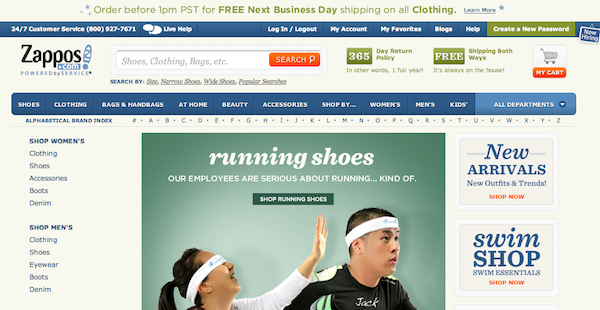Save 50% on a 3-month Digiday+ membership. Ends Dec 5.

There’s no question as to whether Zappos has an interesting approach to marketing, with the company often walking the road less taken. For example, the company uses fan photos as its profile picture on Facebook, hides animations in its mobile apps and has even gone so far as offering new employees $2,000 to quit.
To better illustrate the company’s commitment to being different, and therefore innovative, Digiday interviewed Graham Kahr, social commerce product manager; Matt Burchard, senior director of marketing, photo and video; and Darrin Shamo, director of direct online marketing at Zappos. The executives revealed some interesting things with regards to how Zappos approaches social media, online advertising, video and digital marketing in general. Here is the interview in its entirety:
What would you say is unique in Zappos’ approach to social media?
Kahr: While the Zappos brand fits perfectly with what most marketers define as social media, most of our resources and budget have gone toward driving traffic to our e-commerce site. Our Facebook paid ad efforts to date probably place us in the upper to mid-tier of advertisers. What sets us apart is that about 99 percent of our spend to date has been to drive traffic to our website. We understand that there is top of the funnel activity that occurs through interaction and engagement on Facebook, but we also haven’t found a good way to measure it well enough to optimize around it.
How much do you spend on Facebook ads?
Kahr: Yes. About $8 million spent since starting in June 2010 and about 99 percent of it has been to drive qualified traffic to our website.
What is Zappos’ approach to online video?
Burchard: We are currently not using video in our display/digital efforts, but we plan on exploring this in the near future. We have a vast library of product videos, (over 170,000 created/uploaded in the last three years, currently 98,000 live on Zappos) which we could potentially leverage to create a more product/category specific (contextually relevant) experience within our display advertising.
It’s also worth noting we’re using our in-house video resources to supplement our brand marketing efforts, creating commercials and grassroots content for a fraction of the production costs we’d pay an outside company.
What is Zappos’s overall goal with its digital marketing strategy?
Shamo: The goal with digital marketing efforts are two fold. First, maximize customer acquisition by identifying the right mix of top-, mid- and lower-funnel channel opportunities. Second, carry the Zappos philosophy of building personal emotional connections with all prospects and customers.
Ad position: web_incontent_pos1
Can we get an example of a multichannel digital effort that Zappos has conducted and can you share some results?
Shamo: Given that Zappos is not positioned as a discount retailer, there are few promotional efforts where multichannel support is required. The goal being that all efforts should convey a similar feeling and focus on our consistent value propositions and quirky culture.
This being said, we do on occasion engage in sweepstakes or brand co-ops that require cross-channel support. The results are mixed and vary on the objective of the campaign, but we have found that there is strength in carrying the message across channels when attribution is considered.
What new-media channels is Zappos eying in 2012 and why?
Shamo: While there are many channels that are currently under investigation or testing, mid-funnel display is among the larger opportunities. The size of the audience and developing technologies in the industry make this an opportunity worth further testing from a direct response standpoint. Our focus will be to personalize the experience such that the prospects will see ads with contextually relevant content, personalized product recommendations and delivered at the point where intent is at its height. A good runner up is social pinning sites like Pinterest. This area is growing rapidly and facilitating this organic behavior is top of mind.
More in Marketing

Ulta, Best Buy and Adidas dominate AI holiday shopping mentions
The brands that are seeing the biggest boost from this shift in consumer behavior are some of the biggest retailers.

U.K. retailer Boots leads brand efforts to invest in ad creative’s data layer
For media dollars to make an impact, brands need ad creative that actually hits. More CMOs are investing in pre- and post-flight measurement.

‘AI is permeating everything we do’: How Guitar Center developed 2 AI tools this year
This summer, the company launched a chatbot called Rig Advisor to help customers find the right instruments and products.
Ad position: web_bfu
